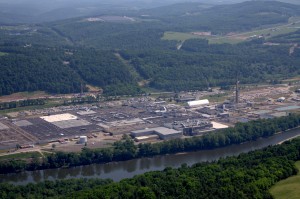Pampers Plant a Model of Sustainability
-
Susan Phillips

courtesy of Proctor and Gamble
A bird’s-eye-view of the Procter & Gamble plant in Wyoming County, Pa.amp; Gamble
For 45 years the Procter & Gamble plant in Mehoopany Township, Wyoming County, was sitting on a shale gas gold mine. But it wasn’t until 2009 that the company realized they had hit the lottery. That’s when Citrus Energy drilled its first well on P&G’s 1400 acre property in Wyoming County, and realized there was a lot of natural gas to tap beneath the ground. Starting February of 2013, Pampers and Luv’s diapers, as well as Charmin’ toilet paper and Bounty paper towels will be manufactured completely off the grid, using P&G’s own Marcellus Shale gas to power the plant, and fuel its fleet of trucks.
Alex Fried, a spokesman for P&G Paper Products, says the six Citrus Energy wells operating on P&G property won’t run dry anytime soon.
“I will be retired and probably dead before that happens,” says Fried. “We’re talking decades.”
Fried says even before the gas was discovered, the company had already begun to make changes that would reduce their energy use. In 2008 P&G installed a papermaking process that captured steam exhaust to generate electricity. Overall, the Fortune 500 company has set sustainability goals for 2020 that include increasing their use of renewable energy sources by 25 percent and sending zero waste to landfills.
In June, 2010, P&G began tapping it’s own shale gas to help power the facility. By October 2011, the gas pipelines that had flowed toward the plant were reversed, and excess gas from their property flowed out to natural gas consumers along the East Coast.
Not only does that save the company money, but it cuts down on lost gas that had to travel up from the Gulf of Mexico. Fried says as the gas travels through the interstate pipeline system, it has to get re-compressed about every two hundred miles, losing about 5 percent of the gas in the process.
The methane that comes out of P&G’s wells is pipeline quality, meaning there’s not much processing that has to happen before it goes to market, or starts generating electricity for the plant. The factory already has a natural gas powered turbine, which was installed back in 1985. Another turbine will allow the plant to be energy self-sufficient by February 2013.
And the plant’s warehouse, which operates 22 trucks, has converted their fleet to compressed natural gas. With two onsite compressors and a fueling station, the company has eliminated their use of 400,000 gallons of diesel fuel a year. Fried says the emissions reduction is equal to taking 145 cars off the road.
He says an added environmental benefit is cleaner burning natural gas from the Marcellus compared with the gas brought up from the Gulf Coast.
“The lottery worked in our favor in this case,” says Fried.
















